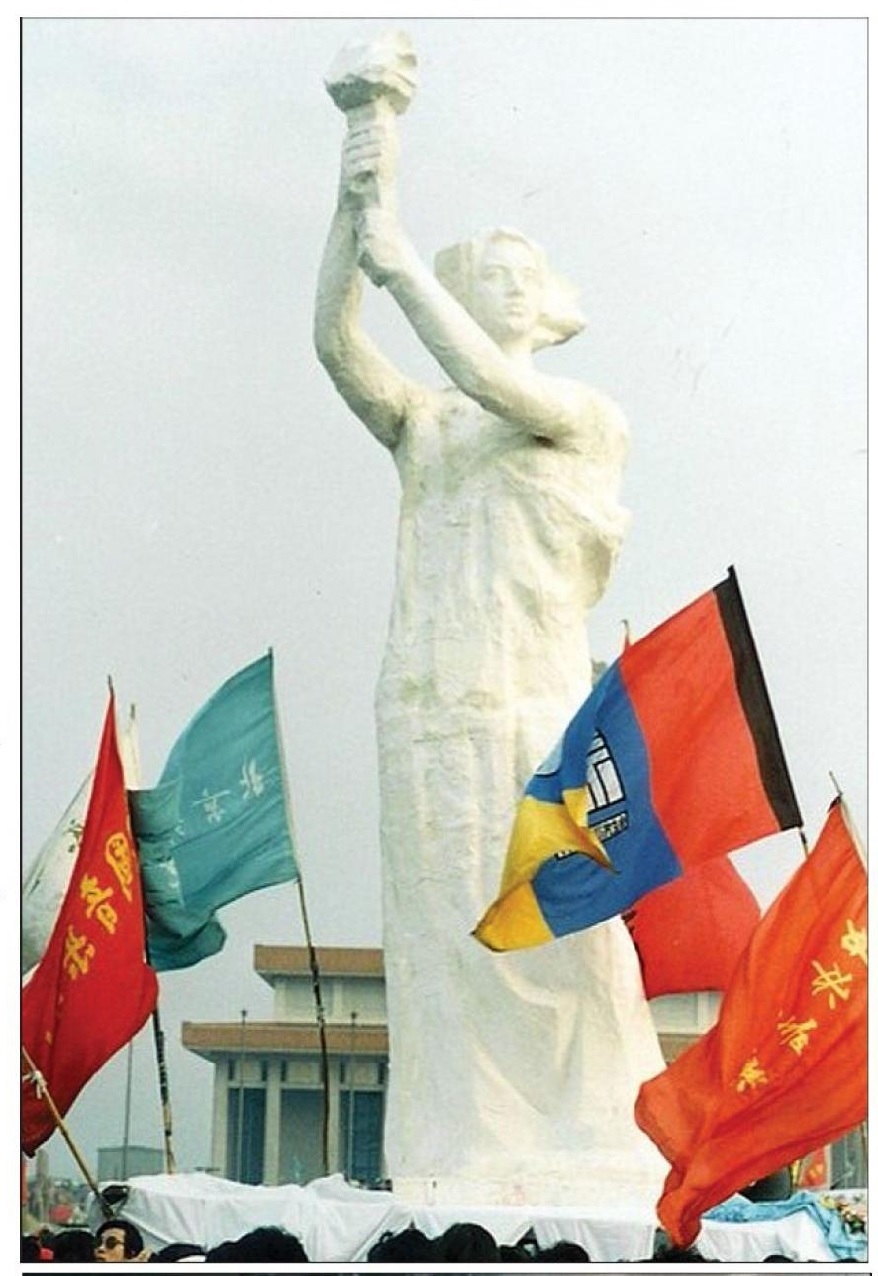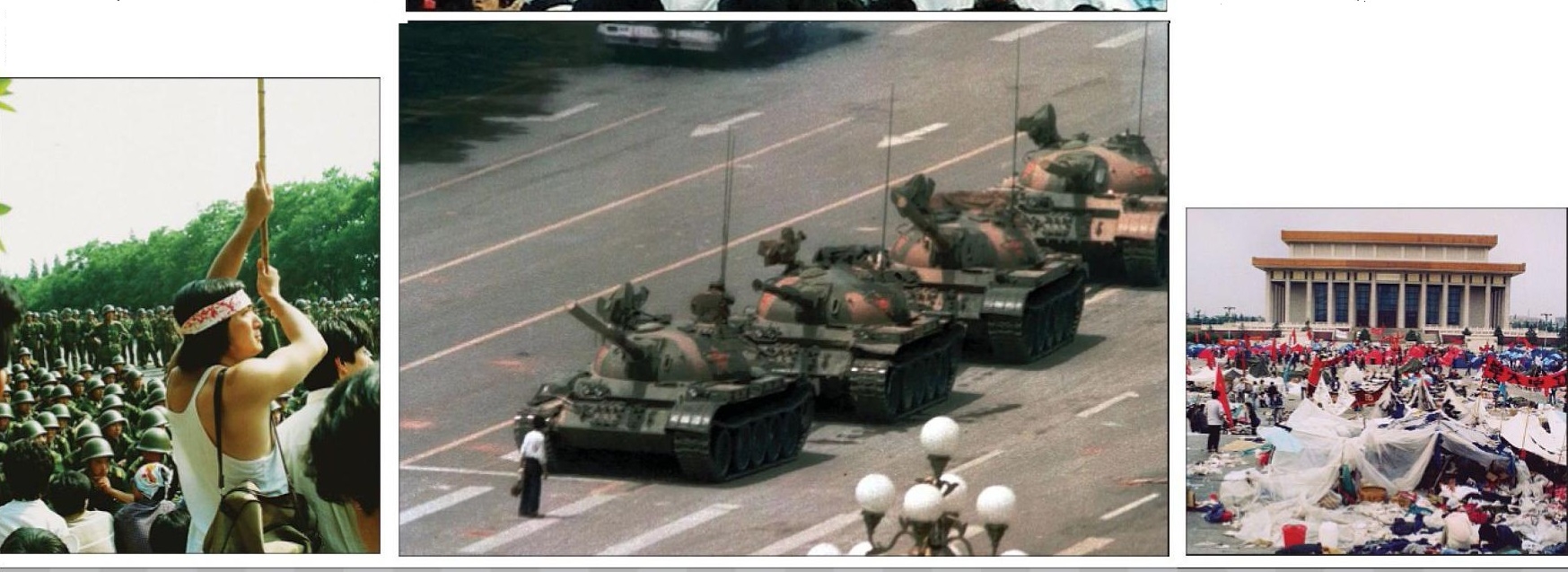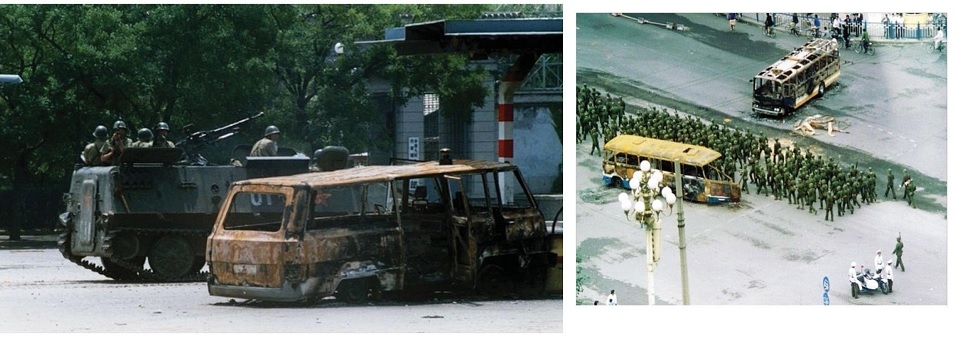Tiananmen Square massacre: A tale of facts in blood, lies in ink
| Date :04-Jun-2023 |

By KARTIK LOKHANDE :
Much has changed in the world since
Communist China’s brutal crackdown on
pro-democracy protesters at Tiananmen Square
on June 3-4, 1989. However, in China, while the
citizens have been keeping the spirit of ‘Goddess
of Democracy’ alive in one way or the other, the
authoratarian regime has been busy tightening
its grip on public life to enforce ‘collective
amnesia’. But, as the recent happenings in
China show, people have not forgotten
Tiananmen Square massacre. The lies in ink
have failed to dilute the facts in blood. As the
ordinary Chinese citizens observe the 34th
anniversary of Tiananmen Square massacre,
‘The Hitavada’ provides a brief recounting of
the past in the light of the present context.

June 3-4, 1989.
These dates are etched in world’s collective
memory as days of bloodbath with specific
reference to Communist China. For, on these two
dates, Chinese government of the day unleased on
its own people - mostly students - the tanks, and
fired shots at them, to crush the 50-day long
pro-democracy protests. What had happened in
that spring and early summer 34 years ago, still
haunts the Communist China. For Chinese people
across the world, the anniversary of the Tinanmen
Square massacre is an occasion to rededicate
themselves to the cause of democracy in the
authoratarian rule in China.
Tinanmen Square ‘massacre’, which the successive Chinese authorities have been trying to sweep
under the carpet as an ‘incident’, brought to an end
the pro-democracy protests spurred by the death of
liberal leader Hu Yaobang on April 15, 1989. Hu
Yaobang was General Secretary of the Chinese
Communist Party (CCP) from 1982-87 till he was
forced to resign due to his views that did not gel well
with those of then Chinese towering figure Deng
Xiaoping. For it to be understood briefly, but in context, one has to go back to 1984-85 when Chinese
economy looked positive but concerns emerged.
Vijay Gokhale, former Ambassador of India to
China and an eyewitness to Tiananmen Square
happenings, has described the situation in China
very well in his masterly book Tiananmen Square: The
Making of a Protest.

He has observed in the book
that though the rural boom due to agriculture sector reforms was at its peak in China in 1984-85,
there were no additional gains in cities. He has also
recorded that there was ‘industrial overheating’ due
to Government spending in infrastructure, doubledigit inflation, and tightening of credit policies was
causing severe growth slump. Besides, fissures
emerged in CCP over proposed urban reforms.
Often, in western discourse on Tiananmen Square
happenings, the fissures within CCP are ignored
and focus is only on discontent among students.
The political fissures were, however, visible to the
public in 1986 when Wang Ruowang, who was
opposed to Deng Xiaoping’s methods, published an
essay titled ‘One Party Dictatorship can only lead to
Tyranny’. Another dissident Fang Lizhi, who was
backed by Hu Yaobang, proposed an academic conference to bring on record what he called ‘true story’ of Chinese dictator Mao’s purge of intellectuals
dating back to 1957. Such purges were regular during Mao’s regime to target the dissidents by
branding them as ‘rightists’ or ‘revisionists’ or
‘supporters of bourgeoise liberalisation’.
The idea of Fang Lizhi, who was at Chinese
University of Science and Technology at Heifei,
evoked a strong response from the authorities, who
decided to not proceed with the idea of electing university student bodies at his university. This started
the first spark leading to Tiananmen Square gradually. In 1986, students protested against this. In
fact, as per the records available, despite the best
efforts of the Communist China to erase those from
public memory, the student protests in 1986 spread
from Heifei to Shenzhen, Shanghai, Wuhan, and
Kunming too. Posters calling for ‘freedom’ and
‘democracy’ appeared at a couple of universities in
Shanghai.
Obviously unhappy, Deng Xiaoping dismissed Hu
Yaobang in January 1987.
Fang Lizhi was demoted
and Wang Ruowang was expelled. Deng tightened
his grip and brought Zhao Ziyang in picture as
General Secretary of CCP. Within two years, differences emerged between Zhao and Deng as the former was more liberal as compared to others.
Meanwhile, though the earlier student protests
were over, the Chinese authorities asked the
Ministry of Public Security to ‘establish units’ inside
key campuses to monitor student activity. State
Education Commission also was asked to ‘send work
teams to prevent big-character posters’. As per the
available records, Deng also was fed up of demonstrations being allowed by liberals and had even told
CCP Central Committee, “If there is a demonstration 365 days a year, nothing can be accomplished
and no foreign investment will come into this
country.”
While the situation was snowballing into a crisis,
Hu Yaobang’s death due to heart attack on April
15, 1989, unleashed the popular displeasure on to
the regime of the day. Soon, posters appeared in
praise of Hu Yaobang, and students gathered across
campuses to discuss his death, and wreaths were
laid for him. This, was the start of the Tiananmen
Square protests of 1989. It grew bigger as number
of students gathering at the Tiananmen Square rose
day after day, criticism about CCP and its leaders
surfaced. The seeds of economic problems and
curbs on people’s lives in Communist China bore the
bitter fruits of popular discontent. The students
demands reflected what ailed China at that time.
They demanded greater opportunities in education
and jobs, elimination of favouritism by way of ceasing extension of benefits to children of party cadres,
personal freedoms, and the Government to become
more responsive and sensitive to needs of citizens.
No Communist country tolerates dissent and
demands for freedoms, and China did not prove to
be an exception. Instead, as the protest extended for
almost 50 days and more and more people started
supporting the students not only at Tiananmen
Square in Beijing but also at other places including
Chengdu, Communist China set a bad example by
ordering military crackdown on own people. People
were mowed down by the tanks, shots were fired,
some were bayoneted on June 3-4.
As the videos of the time reveal, those injured in
firing by the Peoples Liberation Army troops were
carried to hospitals on benches as stretchers were
not available easily. Some ambulances carried the
injured to hospitals. Some of the students carried
their injured friends even on tricycles, with someone tailing or leading on bicycle. The ‘Statue of
Democracy’ made of styrofoam was installed during
the protests, but after June 4 crackdown, the statue
was turned into mangled remains, reflecting how
Communist China crushed democratic aspirations
of own people. In fact, one can understand the enormity of
the tragic loss from a reference in the book The
Tiananmen Papers. “The English-language section of China Radio International was the first
Chinese medium to announce the shocking
news to the world. At 6:25 A.M. on June 4, its
broadcast asked the world to remember the
‘most tragic events’ of June 3, in which it said
‘several thousand people, mostly innocent citizens’ had been killed by ‘heavily armed soldiers’.
It relayed eyewitness accounts of machine-gun
killings and of armored cars running over soldiers who dared to hesitate. It urged its listeners
to protest these horrible violations of human
rights and violent suppression of the people,”
reads a paragraph from the book. Obviously, for
this act of defiance of official diktat, the
Communist regime in China transferred the person in-charge of the English-language section
(who was the son of a Politburo member of
CCP) and investigated him. Besides, all the
employees of the section were forced to write
self-criticisms as is the Communist style.
Though the details came out in the
International knowledge to the extent that the
regime in China could not control initially, the
official exercise of suppression of facts by the
Chinese authorities began soon.
The authoratarian regime resorted to erasing collective
memory through expunging references or what
many call ‘cultural amnesia’ imposed by the
Government. In fact, a book on Tiananmen
massacre has been titled The People’s Republic of
Amnesia. Since then, there has been widespread
detention of journalists, artists, activists and
human rights lawyers ahead of the anniversary
of the Tiananmen Square massacre every year.
There has been an attempt to whitewash the
entire tragic chapter, with tightening of control
over publication and media and even digital
space. As the dissident Fang Lizhi has been
quoted as saying once, “Technique of forgetting
history, has been an important device of rule by
the Chinese Communists.”
But, from whatever material became available
to the other countries of the world, demands
have been growing for China to do full accounting of the massacre. More recently, on June 4,
2020, the Press Secretary of Trump-era White
House issued a Statement commemorating 31st
anniversary of Tiananmen Square massacre.
The statement minced no words and stated,
“The Chinese Communist Party’s slaughter of
unarmed Chinese civilians wasatragedy that
will not be forgotten. The United States calls on
China to honour the memory of those who lost
their lives and to provide a full accounting of
those who were killed, detained, or remain
missing in connection with the events
surrounding the Tiananmen Square massacre
on June 4, 1989.”
Democratic voices have been growing louder
even in Hong Kong, where the world recently
witnessed crackdown by the Communist China
on pro-democracy protesters. Within China
also, voices emerge for accountable and representative governance, freedom of speech,
assembly, religious beliefs, more open and transparent rights-respecting society.
As the world
saw, China was on the brink of ‘Tiananmen 2.0’
last year when tanks were on the streets once
again due to protests taking place against the
strict COVID-19 containment measures. There
was strict monitoring of sale of white cloth following what is known as echoes of ‘Sitong
Bridge protest’ in Beijing by one man in October
2022.
As per a report in The Independent (UK), the
banner put up by the lone protester read, “We
want food, not PCR tests. We want freedom, not
lockdowns. We want respect, not lies. We want
reform, not a Cultural Revolution. We want a
vote, not a leader. We want to be citizens, not
slaves.” He even called Xi Jinping, President of
China, as a ‘dictator and national traitor’. It
soon found echoes in other parts of China as
well as within Chinese community abroad. The
same newspaper reported thatagraffiti on the
walls of a public bathroom in Sichuan read,
“The spirit of 8964 will never be snuffed out.”
Here, ‘8964’ means the date of the Tiananmen
Square massacre with ‘89’ being the year 1989,
‘6’ being the month of June, and ‘4’ signifying
the date of China’s brutal crackdown against
the pro-democracy protesters.
It is but obvious even from the latest incidents
that the pro-democracy spirit in China is still
alive despite the authoratarian regime responding to dissent with censorship, surveillance,
arbitrary detentions, imprisonments, undermining of privacy rights, and attempts to erase
the memories of 1989 from the public mind.
Still, CCP has been continuing with its efforts to
portray 1989 massacre as ‘incident’ and justifying own stand. This is reflected in The Global
Times editorial of June 4, 2021 titled ‘1989 incident provides Chinese people immunity from
colour revolutions’. “If the incident 32 years
ago has any positive effect, that is, it has inoculated the Chinese people with a political vaccine,
helping us acquire immunity from being seriously misled. China underwent a ‘colour revolution’, but wasn’t brought down by it.
The leadership of the Communist Party of China has
saved the fate of the nation at a critical juncture,” it read.
It was the worst that the Tiananmen Square
had seen in China’s modern history. Lu Xun,
considered one of the greatest modern authors
of China, had probably anticipated that such
things might happen again when he wrote
after armed police had opened fire on demonstrators in Tiananmen Square in 1926 to crush
the protest against warlord Zhang Zuolin
accepting Japanese demands. Lu Xun had
prophetically written, “This is not the conclusion of an incident, but a new beginning. Lies
written in ink can never disguise facts written
in blood. All blood debts must be repaid in kind:
the longer the delay, the greater the interest.”
In 1989, after Tiananmen Square massacre,
the students in Chengdu had written on sheets
‘All blood debts must be repaid in blood’.
The book The Tiananmen Papers, published 12
years after 1989, makes a relevant mention at
one place, “The demand to be peacefully heard
wells up again and again from the Chinese people. As China develops, this is bound to be more
true rather than less. Dissenters within and
outside the regime will continue to insist on
being heard.
If there are no channels within
the system, they will go outside. The pressures
both between society and regime, and within
the regime cannot be handled without coming
to terms with the demands raised more than a
decade ago in Tiananmen Square.” Probably,
happenings in China in the past few years are
reflecting this sentiment in Chinese society.
In her wonderful and insightful book The
People’s Republic of Amnesia: Tiananmen Revisited
published in 2014, Louisa Lim has so aptly
summarised the situation of China with reference to Tiananmen Square incident: “The violent suppression of the 1989 movement was
not an anomaly. Its precedents were the May
4th Movement in 1919, the Tiananmen killings
that Lu Xun wrote about in 1926, followed by
the repression of mourning protests after the
death of Zhou Enlai in 1976, and the failed student movement of 1986–1987. Thus, Chinese
history loops endlessly in on itself in a Möbius
strip of crushed aspirations, cycling from one
generation to the next, propelled by the propensity to embrace amnesia.”
But, with rapid changes in the World
Economic Order, globalisation of technology
penetrating the toughest of the firewalls in one
way or the other and posing newer challenges
for the surveillance State, the virtues of democratic values of the free world will someday
breach the collective amnesia of the Chinese
people. Then shall come the true next revolution for the Chinese people, and from the bloodstains deep in the ground at Tiananmen Square
will rise the spirit of the ‘Goddess of
Democracy’. Then, the facts in blood will
triumph over lies in ink in case of China.